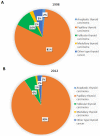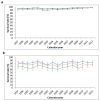Nationwide cohort study on the epidemiology and survival outcomes of thyroid cancer
- PMID: 29108240
- PMCID: PMC5667973
- DOI: 10.18632/oncotarget.19488
Nationwide cohort study on the epidemiology and survival outcomes of thyroid cancer
Abstract
In the past three decades, the thyroid cancer incidence has surged globally. Herein, the Taiwan National Health Insurance database was used to identify thyroid cancer patients and to estimate the prevalence and incidence of thyroid cancer during 1997-2012. The Taiwan Cancer Registry and the National Death Registry databases were crosslinked to obtain information on the histological subtypes and survival rates. Joinpoint regression analysis was used for estimating the average annual percentage changes (APCs) in prevalence, incidence, and survival. The age-standardized incidence of thyroid cancer increased from 5.66 per 100,000 person-years in 1997 to 12.30 per 100,000 person-years in 2012, with an average APC of 5.1 (6.9 in males, 4.6 in females). Thyroid cancer was more prevalent in patients with high socioeconomic status and in urban areas. Papillary carcinoma was the most abundant subtype, with a 2.9-fold increase of incident cases noted during 1998-2012 (from 80.6% to 89.8% of all cases). Among the different treatments, partial thyroidectomy increased the most (average APC, 17.3). The overall survival rates by sex and subtype remained stable over time, with 5-year survival rates of 90.2% in 1997 and 92.4% in 2010. In conclusion, 2.2- and 4.2-fold increases in the incidence and prevalence of thyroid cancer, respectively, were observed during 1997-2012 in Taiwan. The surging incidence of thyroid cancer but stable survival rates, and mainly increased in the papillary subtype, altogether imply enhanced detection of subclinical lesions. A true increase due to environmental carcinogens might also be responsible, but warrant further investigations.
Keywords: National Health Insurance; Taiwan Cancer Registry; epidemiology; survival outcome; thyroid cancer.
Conflict of interest statement
CONFLICTS OF INTEREST The authors declare no conflicts of interest.
Figures











References
-
- Vigneri R, Malandrino P, Vigneri P. The changing epidemiology of thyroid cancer: why is incidence increasing? Curr Opin Oncol. 2015;27:1–7. - PubMed
-
- Ferlay J, Soerjomataram I, Dikshit R, Eser S, Mathers C, Rebelo M, Parkin DM, Forman D, Bray F. Cancer incidence and mortality worldwide: sources, methods and major patterns in GLOBOCAN 2012. Int J Cancer. 2015;136:E359–E386. - PubMed
-
- Cecoli F, Ceresola EM, Altrinetti V, Cabria M, Cappagli M, Montepagani A, Cuttica CM, Filippi U, Saverino D, Raffa M, Caputo M, Minuto F, Giusti M, et al. Therapeutic strategies and clinical outcome in papillary thyroid microcarcinoma: a multicenter observational study. Eur Thyroid J. 2016;5:180–186. - PMC - PubMed
LinkOut - more resources
Full Text Sources
Other Literature Sources
Miscellaneous

